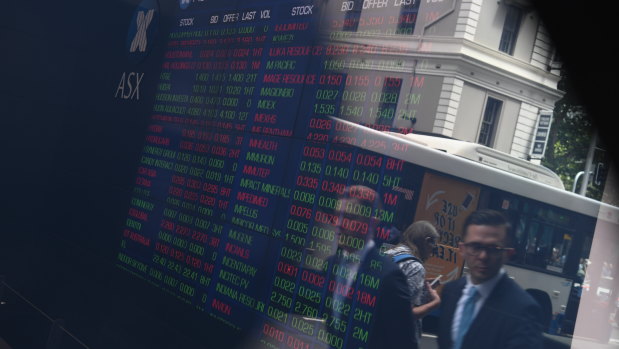By David Scutt
Australian shares suffered the largest fall in over four years on Friday, driven by what some described as panic selling as coronavirus fears escalated sharply.
The benchmark S&P/ASX 200 tumbled 216.7 points, or 3.3 per cent, to close at 6441.2 points, extending the slide from the record highs hit a little over a week ago to over 10.5 per cent.

Australian Securities Exchange in Sydney on Friday. The local bourse tanked almost 10 per cent over the week, wiping about $210 billion off the market's value. Credit: AAP
It was the largest one-day percentage fall since September 29, 2015.
Combined with steep falls over the previous four sessions, the index skidded 9.8 per cent for the week, the largest decline since the height of the GFC in October 2008 and the second-largest fall since the benchmark was created in early 2009. The slide wiped nearly $210 billion off the value of the market.
“I think there’s panic today, genuine panic. These are massive moves,” said Chris Weston, head of research at Pepperstone.
“This isn’t just retail traders getting out. This is systematic money, fund manager money coming out. I don’t want to be a doomsday person, but this feels like the market is preparing itself to something akin to the GFC.”
'I think there’s panic today, genuine panic. These are massive moves.”
Chris Weston, head of research at Pepperstone
Every sector fell by 1 per cent or more during the session, led by materials and information technology, which both slumped 4.7 per cent.
Software company WiseTech was slammed, falling 10.8 per cent to $15.10, closing at a 15-month low having shed over 61 per cent of its value since September last year.
Buy now, pay later provider Afterpay was also hammered, tumbling 9.1 per cent to $33.17.
The big miners dragged the materials sector lower, with BHP shedding 4.5 per cent to close at a 13-month low of $33.60. Rival Rio Tinto dived 3.5 per cent to $87.27.
Financials, the largest sector by market capitalisation, was also hit hard with a fall of 3.1 per cent.
All of the big four banks slumped more than 2.7 per cent, led by the Commonwealth Bank, which fell 3.1 per cent to $81.78. Macquarie Group shed 3.3 per cent to $134.83.
Other blue-chip names were drawn into the downdraft, with CSL sliding 2.5 per cent to $309.44, Newcrest Mining 8 per cent to $26.30, Woolworths 3.5 per cent to $38.80, while Woodside Petroleum skidded 3.5 per cent to $27.92.
Reflecting the tone of the session, of the 20 largest companies on the benchmark index, the top performer was Telstra, which eased 0.3 per cent to $3.43. Next in line was Brambles, which slid 1.7 per cent to $11.96.
“For me right now, the question is what will be the circuit breaker. What is that thing that’s going to cause calm in markets,” said Peppertone’s Weston.
“For a long period of time, equities have done nothing but go up on the premise of liquidity, buy-backs, central bank support and that very low implied volatility will keep going on. What’s happening here is investors being unsure of what the circuit-breaker will be, like we’ve had during other major shocks."
Reflecting heightened uncertainty, the S&P/ASX 200 Volatility Index (VIX) spiked to the highest level since the UK Brexit referendum in June 2016, indicating the skittish moves seen this week could extend well into March given the uncertainty over the potential human and economic toll of the global epidemic.
Mr Weston said it feels as if the crisis has “way more legs” and is different to market pullbacks seen recently.
“Investors see the coronavirus spread outside of China at quite an aggressive pace and that’s all they really care about. They’re not listening to governments. They don’t trust governments because they know politicians are trying to calm the public. They’re looking at the spread of the virus and wondering how much worse it can get,” he said.
“The closure of schools, the quarantining of people and shutting of borders is going to have a massive impact on the global economy, and that’s what we can’t model.
“When we can’t price risk, stock markets do what we’ve seen.”